Dell N1108P-ON, N1124T-ON, N1148T-ON, N1148P-ON, N1108T-ON User Manual
...
Dell Networking N1108T-ON/N1108P-ON/ N1108EP-ON/N1124T-ON/ N1124P-ON/N1148T-ON/ N1148P-ON Switches
Getting Started Guide
Guide de mise en route Handbuch zum Einstieg
Руководство по началу работы
Priručnik za početak rada
Guía de introducción
Başlangı ç Kı lavuzu
הדובע תליחת ךירדמ
Regulatory Model: E17W and E18W
Regulatory Type: E17W001/E18W001/E18W002

Dell Networking
N1108T-ON/N1108P-ON/
N1108EP-ON/N1124T-ON/
N1124P-ON/N1148T-ON/
N1148P-ON Switches
Getting Started Guide
Regulatory Models: E17W and E18W

Notes, Cautions, and Warnings
NOTE: A NOTE indicates important information that helps you make better use of your switch.
CAUTION: A CAUTION indicates either potential damage to hardware or loss of data and tells you how to avoid the problem.
WARNING: A WARNING indicates a potential for property damage, personal injury, or death.
Lithium battery caution:
•There is a danger of explosion if a battery is incorrectly replaced. Replace only with the same or equivalent type. Dispose batteries of according to the manufacturer's instructions.
•Disposing a battery into fire, a hot oven, mechanically crushing, or cutting it can result in an explosion.
•Leaving a battery in an extremely hot environment can result in leakage of flammable liquid, gas, or an explosion.
•If a battery is subjected to extremely low air pressure, it may result in leakage of flammable liquid, gas, or an explosion.
•The device can only be used in a fixed location such as a lab or a machine room. When you install the device, ensure that the protective earthing connection of the socket-outlet is verified by a skilled person.
___________________
© 2019 Dell Inc. or its subsidiaries. All rights reserved. This product is protected by U.S. and international copyright and intellectual property laws. Dell and the Dell logo are trademarks of Dell Inc. in the United States and/or other jurisdictions. All other marks and names mentioned herein may be trademarks of their respective companies.
Regulatory Models: E17W and E18W
May 2019 P/N Y7208 Rev. A01
Contents
1 Introduction . . . . . . . . . . . . . . . . . . . . . . . . |
5 |
N1100-ON Series Hardware Overview . . . . . . . . . . |
5 |
Power Consumption for N1100-ON Series |
5 |
PoE Switches . . . . . . . . . . . . . . . . . . . . . |
|
Ventilation System . . . . . . . . . . . . . . . . . . |
6 |
N1100-ON Series Model Summary . . . . . . . . . . . . |
7 |
2N1108T-ON/N1108P-ON/N1108EP-ON
Installation . . . . . . . . . . . . . . . . . . . . . . . . 8
Mounting an N1108T-ON/N1108P-ON Switch Using
Dell Tandem Tray . . . . . . . . . . . . . . . . . . . . . 8
Mounting an N1108T-ON/N1108P-ON/N1108EP-ON
on a Two-Post Rack Using Large L-brackets . . . . . . . 9
Mounting all N11xx-ON Switches on a Wall . . . . . . 10
3N1124T-ON/N1124P-ON/N1148T-ON/ N1148P-ON Installation . . . . . . . . . . . . . . 13
Rack Mounting an N1124T-ON/N1124P-ON/ |
|
|
|
N1148T-ON/ N1148P-ON Switch. . . . . . . . . . . . . |
13 |
|
|
Installing in a Rack . . . . . . . . . . . . . . . . . |
13 |
|
|
Installing as a Free-standing Switch . . . . . . . . |
14 |
|
|
Stacking Multiple N1124T-ON/N1124P-ON/ |
|
|
|
N1148T-ON/ N1148P-ON Switches . . . . . . . . . . . |
14 |
|
|
Contents |
|
|
3 |
|

4Starting and Configuring the
N1100-ON Series Switch . . . . . . . . . . . . . 15
Connecting an N1100-ON Series Switch to
a Terminal . . . . . . . . . . . . . . . . . . . . . . . . |
16 |
Connecting an N1100-ON Series Switch to |
|
a Power Source . . . . . . . . . . . . . . . . . . . . . |
17 |
AC and DC Power Connection . . . . . . . . . . . |
17 |
Booting the N1100-ON Series Switch . . . . . . . . . . |
18 |
Performing the N1100-ON Series |
|
Initial Configuration . . . . . . . . . . . . . . . . . . . |
19 |
Enabling Remote Management . . . . . . . . . . . |
19 |
Initial Configuration Procedure . . . . . . . . . . . |
20 |
Example Session . . . . . . . . . . . . . . . . . . |
21 |
Dell Easy Setup Wizard Console Example . . . . . |
22 |
Next Steps . . . . . . . . . . . . . . . . . . . . . |
26 |
5 Agency compliance . . . . . . . . . . . . . . . . |
28 |
4 Contents

Introduction
This document provides basic information about the Dell Networking N1100-ON Series switches, including how to install a switch and perform the initial configuration. For information about how to configure and monitor switch features, refer to the User Configuration Guide, which is available on the Dell Support website at dell.com/support. See the Support website for the latest updates on documentation and firmware.
NOTE: Switch administrators are strongly advised to maintain Dell Networking switches on the latest version of the Dell Networking Operating System (DNOS). Dell Networking continually improves the features and functions of DNOS based on feedback from you, the customer. For critical infrastructure, pre-staging of the new release into a non-critical portion of the network is recommended to verify network configuration and operation with the new DNOS version.
N1100-ON Series Hardware Overview
This section contains information about device characteristics and modular hardware configurations for the Dell Networking N1100-ON Series switch.
NOTE: The N1108EP-ON switch uses an external power adaptor. There is no mounting kit available for the N1108EP-ON external power adaptor. When installing the N1108EP-ON, place the external power adaptor away from the switch.
Power Consumption for N1100-ON Series PoE Switches
Table 1-1 describes the power consumption for N1100-ON Series PoE switches. The PoE power budget is 60W for the N1108P-ON, 123W for the N1108EP-ON, 185W for the N1124P-ON, and 370W for the N1148P-ON.
Table 1-1. Power Consumption for N1100-ON Series PoE Switches
Model |
Input Voltage |
Power Supply |
Maximum Steady |
Maximum |
|
|
Configuration |
Current |
Steady |
|
|
|
Consumption (A) |
Power (W) |
|
|
|
|
|
N1108P-ON |
100V/60Hz |
Main PSU |
0.95A |
88.64W |
|
110V/60Hz |
Main PSU |
0.87A |
88.43W |
|
120V/60Hz |
Main PSU |
0.80A |
88.22W |
|
220V/50Hz |
Main PSU |
0.49A |
89.28W |
|
240V/50Hz |
Main PSU |
0.45A |
89.70W |
Getting Started Guide |
|
5 |
|

Model |
Input Voltage |
Power Supply |
Maximum Steady |
Maximum |
|
|
Configuration |
Current |
Steady |
|
|
|
Consumption (A) |
Power (W) |
|
|
|
|
|
N1108EP-ON 100V/60Hz |
54VDC External |
1.62A |
157W |
|
|
|
power adaptor |
|
|
|
110V/60Hz |
54VDC External |
1.47A |
157W |
|
|
power adaptor |
|
|
|
120V/60Hz |
54VDC External |
1.35A |
157W |
|
|
power adaptor |
|
|
|
220V/50Hz |
54VDC External |
0.74A |
157W |
|
|
power adaptor |
|
|
|
240V/50Hz |
54VDC External |
0.67A |
157W |
|
|
power adaptor |
|
|
N1124P-ON |
100V/60Hz |
Main PSU |
2.66A |
260.66W |
|
110V/60Hz |
Main PSU |
2.38A |
257.95W |
|
120V/60Hz |
Main PSU |
2.16A |
256.27W |
|
220V/50Hz |
Main PSU |
1.18A |
250.52W |
|
240V/50Hz |
Main PSU |
1.10A |
251.25W |
N1148P-ON |
100V/60Hz |
Main PSU |
4.78A |
476.03W |
|
110V/60Hz |
Main PSU |
4.32A |
472.64W |
|
120V/60Hz |
Main PSU |
3.95A |
470.58W |
|
220V/50Hz |
Main PSU |
2.14A |
459.37W |
|
240V/50Hz |
Main PSU |
1.97A |
459.06W |
|
|
|
|
|
Ventilation System
One fan cools the N1108T-ON/N1108P-ON switches, and two fans cool the N1024T-ON/N1024P-ON/N1048T-ON/N1048P-ON switches. The fans are not field replaceable. The N1108EP-ON is a fanless switch.
6 |
|
Getting Started Guide |
|

N1100-ON Series Model Summary
Table 1-2. N1100-ON Series Switch Regulatory Numbers
Marketing |
Description |
Power Supply |
Regulatory |
Regulatory |
Model Name |
|
Unit (PSU) |
Model Number |
TypeNumber |
(MMN) |
|
|
(RMN) |
(RTN) |
|
|
|
|
|
N1108T-ON |
10x1G/2x1G SFP Ports |
DPS-24GP |
E17W |
E17W001 |
N1108P-ON |
10x1G/2x1G SFP/2xPoE+ Ports |
DPS-80AP/ |
E17W |
E17W001 |
|
|
DPS-24GP |
|
|
N1108EP-ON 8x1G PoE+/2x1G PD/2x1G SFP |
ADP-280BR |
E48W |
E48W001 |
|
|
Ports |
|
|
|
N1124T-ON |
24x1G/4x10G SFP+ Ports |
DPS-40AP |
E18W |
E18W001 |
N1124P-ON |
24x1G/4x10G SFP+/6xPoE+ Ports |
EDPS-250BF |
E18W |
E18W001 |
N1148T-ON |
48x1G/4x10G SFP+ Ports |
DPS-60AP |
E18W |
E18W002 |
N1148P-ON |
48x1G/4x10G SFP+/12xPoE+ Port |
YM-2501D |
E18W |
E18W002 |
|
|
|
|
|
Getting Started Guide |
|
7 |
|

N1108T-ON/N1108P-ON/N1108EP-ON
Installation
Mounting an N1108T-ON/N1108P-ON Switch Using Dell Tandem Tray
The AC power connector is on the rear panel.
WARNING: Read the safety information in the Safety and Regulatory Information as well as the safety information for other switches that connect to or support the switch.
WARNING: Do not use rack mounting kits to suspend the switch from under a table or desk, or attach it to a wall.
CAUTION: Disconnect all cables from the switch before continuing. Remove all self-adhesive pads from the underside of the switch, if they have been attached.
CAUTION: When mounting multiple switches into a rack, mount the switches from the bottom up.
1Secure the N1108T-ON/N1108P-ON switch in the Dell Tandem Tray Kit as shown in Figure 1-1.
Figure 1-1. Dell Tandem Tray Kit
2Insert the switch into the 48.26 cm (19 inch) rack, ensuring that the rack mounting holes on the kit line up to the mounting holes in the rack.
8 |
|
Getting Started Guide |
|
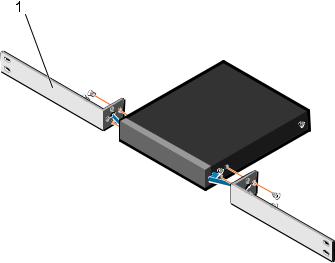
3Secure the kit to the rack with either the rack bolts or cage nuts and cagenut bolts with washers (depending on the kind of rack you have). Fasten the bolts on the bottom before fastening the bolts on the top.
Mounting an N1108T-ON/N1108P-ON/N1108EP- ON on a Two-Post Rack Using Large L-brackets
NOTE: The AC power connector is on the rear panel of the N1108T-ON/N1108P-ON switches. The DC power connector for the N1108EP-ON is at the center of the rear panel.
NOTE: The N1108EP-ON switch uses an external power adaptor. There is no mounting kit available for the N1108EP-ON external power adaptor. When installing the N1108EP-ON, place the external power adaptor away from the switch.
CAUTION: As the N1108EP-ON is a fanless switch, do not place the external power adaptor on top of the switch to avoid overheating.
1Place the supplied rack-mounting bracket on one side of the switch making sure that the mounting holes on the switch line up to the mounting holes on the rack mounting bracket. See item 1 in Figure 1-2.
Figure 1-2. Installing Using Large L-bracket Kit
2Insert the supplied screws into the rack mounting holes and tighten with a screwdriver.
3Repeat the process on the other side of the switch.
Getting Started Guide |
|
9 |
|
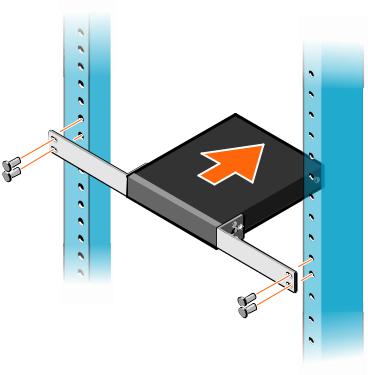
4Insert the switch and rail assembly into the rack from the front of the rack. Make sure that the rack-mounting holes on the switch line up to the mounting holes on the rack.
5Secure the switch to the rack with the rack screws. Fasten the lower pair of screws before the upper pair of screws. See Figure 1-3.
Figure 1-3. Install on a Two-post Rack with L-Bracket
Mounting all N11xx-ON Switches on a Wall
1Make sure that the mounting location meets the following requirements:
•The surface of the wall can support the switch.
•The location is ventilated to prevent heat buildup.
2Place the supplied wall-mounting bracket on one side of the switch, verifying that the mounting holes on the switch line up to the mounting holes on the wall-mounting bracket.
3Insert the supplied screws into the wall-mounting bracket holes and tighten with a screwdriver. See Figure 1-4.
10 |
|
Getting Started Guide |
|
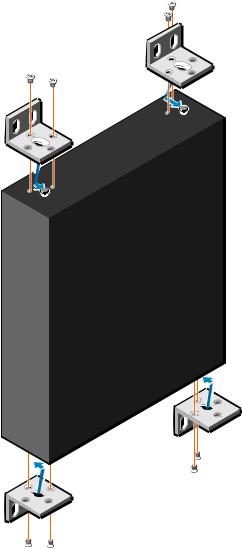
Figure 1-4. Inserting Mounting Brackets
4Repeat the process for the wall-mounting bracket on the other side of the switch.
5Place the switch on the wall in the location where the switch is being installed.
6Mark the locations on the wall where the screws to hold the switch must be prepared.
7On the marked locations, drill the holes and place all the eight supplied anchors in the holes.
8Insert the supplied screws into the wall-mounting bracket holes and tighten them with a screwdriver. See Figure 1-5.
Getting Started Guide |
|
11 |
|
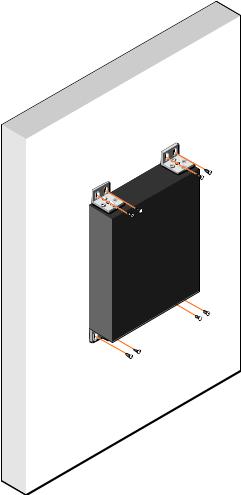
Figure 1-5. Mounting on a Wall
12 |
|
Getting Started Guide |
|
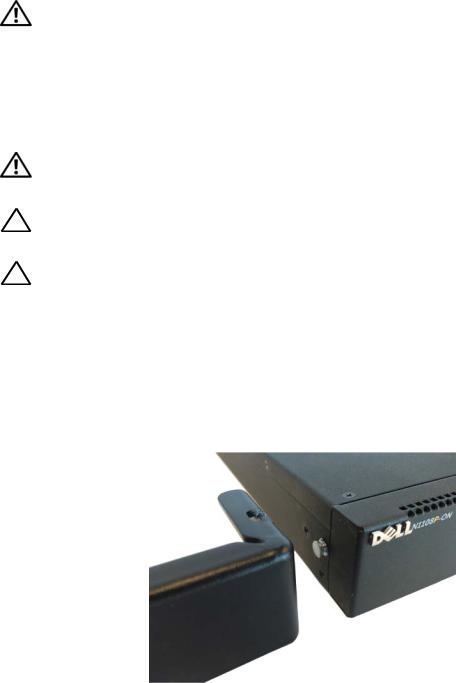
N1124T-ON/N1124P-ON/N1148T-ON/
N1148P-ON Installation
Rack Mounting an N1124T-ON/N1124P-ON/
N1148T-ON/ N1148P-ON Switch
WARNING: Read the safety information in the Safety and Regulatory Information as well as the safety information for other switches that connect to or support the switch.
The AC power connector is on the rear panel of the switch.
Installing in a Rack
WARNING: Do not use rack mounting kits to suspend the switch from under a table or desk, or attach it to a wall.
CAUTION: Disconnect all cables from the switch before continuing. Remove all self-adhesive pads from the underside of the switch, if they have been attached.
CAUTION: When mounting multiple switches into a rack, mount the switches from the bottom up.
1Place the supplied rack-mounting bracket on one side of the switch, ensuring that the mounting holes on the switch line up to the mounting holes in the rack-mounting bracket. Figure 1-6 illustrates where to mount the brackets.
Figure 1-6. Attaching the Brackets
Getting Started Guide |
|
13 |
|

2Insert the supplied bolts into the rack-mounting holes and tighten with a screwdriver.
3Repeat the process for the rack-mounting bracket on the other side of the switch.
4Insert the switch into the 48.26 cm (19 inch) rack, ensuring that the rackmounting holes on the bracket line up with the mounting holes in the rack.
5Secure the bracket to the rack with either the rack bolts or cage nuts and cage-nut bolts with washers (depending on the kind of rack you have). Fasten the bolts on the bottom before fastening the bolts on the top.
CAUTION: Make sure that the supplied rack bolts fit the pre-threaded holes in the rack.
NOTE: Make sure that the ventilation holes are not obstructed.
Installing as a Free-standing Switch
NOTE: Dell strongly recommends mounting the switch in a rack.
Install the switch on a flat surface if you are not installing it in a rack. The surface must be able to support the weight of the switch and the switch cables. The switch is supplied with four self-adhesive rubber pads.
1Attach the self-adhesive rubber pads on each location marked on the bottom of the switch.
2Set the switch on a flat surface, and make sure that it has proper ventilation by leaving 5 cm (2 inches) on each side and 13 cm (5 inches) at the back.
Stacking Multiple N1124T-ON/N1124P-ON/ N1148T-ON/ N1148P-ON Switches
You can stack N1124T-ON/N1124P-ON/N1148T-ON/ N1148P-ON switches up to four switches high using 10G SFP+ ports on the front of the switch. The ports must be configured to support stacking. When multiple switches are connected together through the stack ports, they operate as a single unit with up to 208 front-panel ports. The stack operates and is managed as a single entity. Refer to the User Configuration Guide and the CLI Reference Guide for more information.
14 |
|
Getting Started Guide |
|
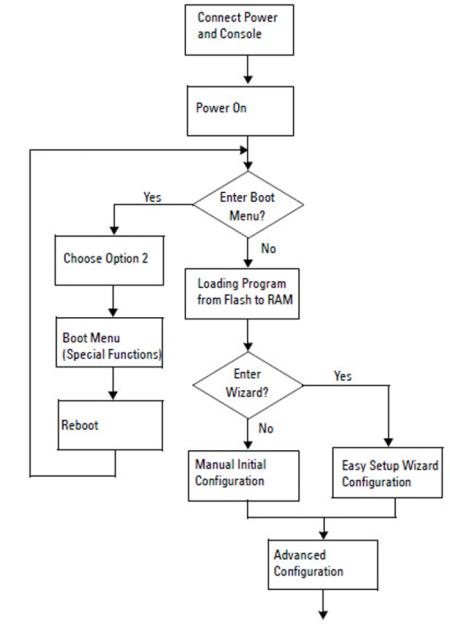
Starting and Configuring the
N1100-ON Series Switch
The following flow chart provides an overview of the steps you use to perform the initial configuration after the switch is unpacked and mounted.
Figure 1-7. Installation and Configuration Flow Chart
Getting Started Guide |
|
15 |
|

Connecting an N1100-ON Series Switch to a Terminal
After completing all external connections, configure the switch by connecting it to a terminal.
NOTE: Read the Release Notes for this product before proceeding. You can download the Release Notes from the Dell Support website at dell.com/support.
NOTE: Dell recommends that you obtain the most recent version of the user documentation from the Dell Support website at dell.com/support.
To monitor and configure the switch via the USB console, use the console port on the front panel of the switch to connect it to a computer running VT100 terminal emulation software using the supplied USB cable. It may be necessary to download and install a driver on first use of the USB cable.
The following equipment is required to use the console port:
•VT100-compatible computer with a USB port running VT100 terminal emulation software, such as HyperTerminal® and a USB driver.
•The supplied USB cable with a type B USB connector for the console port and USB connector for the host PC.
Perform the following tasks to connect a terminal to the switch console port:
1Connect the USB type B connector on the supplied switch and connect the other end to a computer running VT100 terminal emulation software.
2Configure the terminal emulation software as follows:
a Select the appropriate serial port (for example, COM 1) to connect to the console.
b Set the data rate to 115,200 baud.
c Set the data format to 8 data bits, 1 stop bit, and no parity. d Set the flow control to none.
e Set the terminal emulation mode to VT100.
fSelect Terminal keys for Function, Arrow, and Ctrl keys. Make sure that the setting is for Terminal keys (not Microsoft Windows keys).
3Connect the USB type B connector on the cable directly to the switch console port. The Dell Networking console port is located on the right side of the front panel and is labeled with a |O|O| symbol.
16 |
|
Getting Started Guide |
|

NOTE: Console access to the stack manager is available from any console port via the local CLI. Only one USB console session at a time is supported.
Connecting an N1100-ON Series Switch to a Power Source
CAUTION: Read the safety information in the Safety and Regulatory Information manual as well as the safety information for other switches that connect to or support the switch.
The N1108T-ON and N1108P-ON models have one internal power supply. The power receptacle is on the rear panel. N1108EP-ON uses an external DC power adaptor. The external DC power adaptor
AC and DC Power Connection
1Make sure that the switch console port is connected to a PC running a VT100 terminal emulator via the USB to USB Type B cable.
2Using a 5-foot (1.5 m) standard power cable with safety ground connected, connect the power cable to the AC main receptacle located on the rear panel.
The PoE model switches have a heavy-duty power cable with a notched connector for the switch power receptacle. Use of this type of cable is mandatory for PoE-capable switches.
3Connect the power cable to a grounded AC outlet.
Getting Started Guide |
|
17 |
|
Booting the N1100-ON Series Switch
When the power is turned on with the local terminal already connected, the switch goes through a power-on self-test (POST). POST runs every time the switch is initialized and checks hardware components to determine if the switch is fully operational before completely booting. If POST detects a critical problem, the program flow stops. If POST passes successfully, valid firmware is loaded into RAM. POST messages are displayed on the terminal and indicate test success or failure. The boot process runs for approximately 60 seconds.
You can invoke the Boot menu after the first part of the POST is completed. From the Boot menu, you can perform configuration tasks such as resetting the system to factory defaults, activating the backup image, or recovering a password. For more information about the Boot menu functions, refer to the
CLI Reference Guide.
18 |
|
Getting Started Guide |
|

Performing the N1100-ON Series Initial Configuration
The initial configuration procedure is based on the following assumptions:
•The Dell Networking switch was never configured before.
•The Dell Networking switch booted successfully.
•The console connection was established, and the Dell Easy Setup Wizard prompt appears on the screen of a PC running terminal emulation software.
The initial switch configuration is performed through the console port. After the initial configuration, you can manage the switch from the alreadyconnected console port or remotely through an interface defined during the initial configuration.
NOTE: The switch is not configured with a default user name, password, or IP address.
Before setting up the initial configuration of the switch, obtain the following information from your network administrator:
•The IP address to be assigned to the management interface.
•The IP subnet mask for the network.
•The IP address of the management interface default gateway.
These settings are necessary to allow the remote management of the switch through Telnet (Telnet client) or HTTP (Web browser).
Enabling Remote Management
On the N1100-ON Series switches, you can use any of the switch ports on the front panel for in-band management. By default, all in-band ports are members of VLAN 1.
The Dell Easy Setup Wizard includes prompts to configure network information for the VLAN 1 interface on the N1100-ON Series switches. You can assign a static IP address and subnet mask or enable DHCP and allow a network DHCP server to assign the information.
Refer to the CLI Reference Guide for commands to configure network information.
Getting Started Guide |
|
19 |
|

Initial Configuration Procedure
Perform the initial configuration by using the Dell Easy Setup Wizard or by using the CLI. The wizard automatically starts when the switch configuration file is empty. Exit the wizard at any point by entering [ctrl+z], but all configuration settings specified will be discarded, and the switch will use the default values.
NOTE: If you do not run the Dell Easy Setup Wizard or do not respond to the initial Easy Setup Wizard prompt within 60 seconds, the switch enters CLI mode. You must reset the switch with an empty startup configuration in order to rerun the Dell Easy Setup Wizard.
For more information about performing the initial configuration by using the CLI, refer to the CLI Reference Guide. This Getting Started Guide shows how to use the Dell Easy Setup Wizard for initial switch configuration. The wizard sets up the following configuration on the switch:
•Establishes the initial privileged user account with a valid password. The wizard configures one privileged user account during the setup.
•Enables CLI login and HTTP access to use the local authentication setting only.
•Sets up the IP address for the VLAN 1 routing interface, of which all in-band ports are members.
•Sets up the SNMP community string to be used by the SNMP manager at a given IP address. Skip this step if SNMP management is not used for this switch.
•Allows you to specify the network management system IP address or permit management access from all IP addresses.
•Configures the default gateway IP address for the VLAN 1 interface.
20 |
|
Getting Started Guide |
|

Example Session
This section describes a Dell Easy Setup Wizard session. The following values are used by the example session:
•The SNMP community string to be used is public.
•The network management system (NMS) IP address is 10.1.2.100.
•The user name is admin, and the password is admin123.
•The IP address for the VLAN 1 routing interface is 10.1.1.200 with a subnet mask of 255.255.255.0.
•The default gateway is 10.1.1.1.
The setup wizard configures the initial values as defined above. After completing the wizard, the switch is configured as follows:
•SNMPv2 is enabled and the community string is set up as defined above. SNMPv3 is disabled by default.
•The admin user account is set up as defined.
•A network management system is configured. From the management station, you can access the SNMP, HTTP, and CLI interfaces. You may also choose to allow all IP addresses to access these management interfaces by choosing the (0.0.0.0) IP address.
•An IP address is configured for the VLAN 1 routing interface.
•A default gateway address is configured.
NOTE: In the following example, the possible user options or default values are enclosed in [ ]. If you press <Enter> with no options defined, the default value is accepted. Help text is in parentheses.
Getting Started Guide |
|
21 |
|
Dell Easy Setup Wizard Console Example
The following example contains the sequence of prompts and responses associated with running an example Dell Easy Setup Wizard session, using the input values listed earlier.
After the switch completes the POST and is booted, the following dialog appears:
Unit 1 - Waiting to select management unit)>
___________Dell SupportAssist EULA__________________
I accept the terms of the license agreement. You can reject the license agreement by configuring this command 'eula-consent support-assist reject'.
By installing SupportAssist, you allow Dell to save your contact information (e.g. name, phone number and/or email address) which would be used to provide technical support for your Dell products and services Dell may use the information for providing recommendations to improve your IT infrastructure. Dell SupportAssist also collects and stores machine diagnostic information, which may include but is not limited to configuration information, user supplied contact information, names of data volumes, IP addresses, access control lists, diagnostics & performance information, network configuration information, host/server configuration & performance information and related data (Collected Data) and transmits this information to Dell. By downloading SupportAssist and agreeing to be bound by these terms and the Dell end user license agreement, available at: http://www.dell.com/aeula, you agree to allow Dell to provide remote monitoring services of your IT environment and you give Dell the right to collect the Collected Data in accordance with Dell's Privacy Policy, available at: http://www.dell.com/privacypolicycountryspecific, in order to enable the performance of all of the various functions of SupportAssist during your entitlement to
22 |
|
Getting Started Guide |
|
receive related repair services from Dell. You further agree to allow Dell to transmit and store the Collected Data from SupportAssist in accordance with these terms. You agree that the provision of SupportAssist may involve international transfers of data from you to Dell and/or to Dell's affiliates, subcontractors or business partners. When making such transfers, Dell shall ensure appropriate protection is in place to safeguard the Collected Data being transferred in connection with SupportAssist. If you are downloading SupportAssist on behalf of a company or other legal entity, you are further certifying to Dell that you have appropriate authority to provide this consent on behalf of that entity. If you do not consent to the collection, transmission and/or use of the Collected Data, you may not download, install or otherwise use SupportAssist.
________AeroHive HiveManager NG EULA________________
This switch includes a feature that enables it to work with HiveManager (an optional management suite), by sending the switch's service tag number and IP Address to HiveManager to authenticate your entitlement to use HiveManager. If you wish to disable this feature, you should run command 'eula-consent hiveagent reject' immediately upon powering up the switch for the first time, or at any time thereafter.
Applying Global configuration, please wait...
Welcome to Dell Easy Setup Wizard
The setup wizard guides you through the initial switch configuration, and gets you up and running as quickly as possible. You can skip the setup wizard, and enter CLI mode to manually configure the switch. You must respond to the next question to run the setup wizard within 60 seconds, otherwise the system will continue
Getting Started Guide |
|
23 |
|

with normal operation using the default system configuration. Note: You can exit the setup wizard at any point by entering [ctrl+z].
Would you like to run the setup wizard (you must answer this question within 60 seconds)? [Y/N] y
Step 1:
The system is not set up for SNMP management by default. To manage the switch using SNMP (required for Dell Network Manager) you can
. Set up the initial SNMP version 2 account now.
. Return later and set up other SNMP accounts. (For more information on setting up an SNMP version 1 or 3 account, see the user documentation).
Would you like to set up the SNMP management interface now? [Y/N] y
To set up the SNMP management account you must specify the management system IP address and the “community string” or password that the particular management system uses to access the switch. The wizard automatically assigns the highest access level [Privilege Level 15] to this account. You can use Dell Network Manager or other management interfaces to change this setting, and to add additional management system information later. For more information on adding management systems, see the user documentation.
To add a management station:
Please enter the SNMP community string to be used. [public]: public
NOTE: If it is configured, the default access level is set to the highest available access for the SNMP management interface. Initially only SNMPv2 will be activated. SNMPv3 is disabled until you return to configure security access for SNMPv3 (e.g. engine ID, view, etc.).
Please enter the IP address of the Management System (A.B.C.D) or wildcard (0.0.0.0) to manage from any Management Station. [0.0.0.0]: 10.1.2.100
24 |
|
Getting Started Guide |
|
Step 2:
Now we need to set up your initial privilege (Level 15) user account. This account is used to login to the CLI and Web interface. You may set up other accounts and change privilege levels later. For more information on setting up user accounts and changing privilege levels, see the user documentation.
To set up a user account:
Please enter the user name. [root]:admin Please enter the user password: ********
Please reenter the user password: ********
Step 3:
Next, an IP address is set up on the VLAN 1 routing interface.
You can use the IP address to access the CLI, Web interface, or SNMP interface of the switch.
To access the switch through any Management Interface you can
. Set up the IP address for the Management Interface.
. Set up the default gateway if IP address is manually configured on the routing interface.
Step 4:
Would you like to set up the VLAN1 routing interface now? [Y/N] y
Please enter the IP address of the device (A.B.C.D) or enter “DHCP” (without the quotes) to automatically request an IP address from the network DHCP server:
10.1.1.200
Please enter the IP subnet mask (A.B.C.D or /nn):
255.255.255.0
Step 5:
Getting Started Guide |
|
25 |
|
Finally, set up the default gateway. Please enter the IP address of the gateway from which this network is reachable. [0.0.0.0]: 10.1.1.1
This is the configuration information that has been collected:
SNMP Interface = “public”@10.1.2.100 User Account setup = admin
Password = ********
VLAN1 Router Interface IP = 10.1.1.200 255.255.255.0 Default Gateway = 10.1.1.1
Step 6:
If the information is correct, please enter (Y) to save the configuration and copy the settings to the start-up configuration file. If the information is incorrect, enter (N) to discard the configuration and restart the wizard: [Y/N] y
Thank you for using the Dell Easy Setup Wizard. You will now enter CLI mode.
Applying Interface configuration, please wait...
Next Steps
After completing the initial configuration described in this section, connect any of the front-panel switch ports to a production network for in-band remote management.
If you specified DHCP for the VLAN 1 management interface IP address, the interface will acquire its IP address from a DHCP server on the network. To discover the dynamically assigned IP address, use the console port connection to issue the following command:
•For the VLAN 1 routing interface, enter show ip interface.
To access the Dell OpenManage Switch Administrator interface, enter the VLAN 1 management interface IP address into the address field of a Web browser. For remote management access to the CLI, enter the VLAN 1 management interface IP address into a Telnet or SSH client. Alternatively, continue to use the console port for local CLI access to the switch.
26 |
|
Getting Started Guide |
|
The N1100-ON Series switches support basic switching features such as VLANs and spanning tree protocol. Use the Web-based management interface or the CLI to configure the features your network requires. For information about how to configure the switch features, refer to the User Configuration Guide or CLI Reference Guide available on the support site: dell.com/support.
Getting Started Guide |
|
27 |
|
Agency compliance
The N1108T-ON, N1108P-ON, N1108EP-ON, N1124T-ON, N1124P-ON, N1148T-ON, and N1148P-ON switches comply with the following safety and agency requirements:
European Union EMC directive conformance statement
This product is in conformity with the protection requirements of EU Council Directive 2004/30/EC on the approximation of the laws of the Member States relating to electromagnetic compatibility. Dell EMC cannot accept responsibility for any failure to satisfy the protection requirements resulting from a non-recommended modification of this product, including the fitting of non-Dell EMC option cards.
This product has been tested and found to comply with the limits for Class A Information Technology Equipment according to CISPR 32/CISPR34 and EN55032 / EN55034. The limits for Class A equipment were derived for commercial and industrial environments to provide reasonable protection against interference with licensed communication equipment.
WARNING: This is a Class A product. In a domestic environment, this device may cause radio interference, in which case, you may be required to take adequate measures.
European Community Contact: Dell EMC, EMEA - Central Dahlienweg 19
66265 Heusweiler Germany
Tel: +49 172 6802630 Email: EMEA Central Sales
India certification of compliance
The product conforms to the relevant Essential Requirements of Telecommunication Engineering Centre (TEC) regulations.
28 |
|
Getting Started Guide |
|
Safety standards and compliance agency certifications
•IEC 62368-1, 2nd Edition
•CUS UL 60950-1, 2nd Edition
•Meets or exceeds Hi Pot and Ground Continuity testing per UL 60950-1.
•AS/NZS 60950
•CSA 60950-1-03, 2nd Edition
•EN 60950-1, 2nd Edition
•EN 60825-1, 1st Edition
•EN 60825-1 Safety of Laser Products—Part 1: Equipment Classification Requirements and User’s Guide
•EN 60825-2 Safety of Laser Products—Part 2: Safety of Optical Fibre Communication Systems
•FDA Regulation 21CFR 1040.10 and 1040.11
•IEC 60950-1, 2nd Ed, including all National Deviations and Group Differences
Electromagnetic compatibility
Emissions
•International: CISPR 32: Class A
•Australia/New Zealand: AS/NZS CISPR 32, Class A
•Canada: ICES-003, Issue-4, Class A
•Europe: EN55032:2015 (CISPR 32), Class A
•EN55032
•Japan: VCCI Class A
•Korea: KN32, Class A
•Taiwan: CNS13438, Class A
•USA: FCC CFR47 Part 15, Subpart B, Class A
Getting Started Guide |
|
29 |
|
